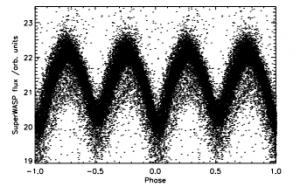 More triple stars in the news!
More triple stars in the news!
We report our investigation of 1SWASP J234401.81-212229.1, a variable with a 18461.6 s period. After identification in a 2011 search of the SuperWASP archive for main-sequence eclipsing binary candidates near the distribution's short-period limit of approx. 0.20 d, it was measured to be undergoing rapid period decrease in our earlier work, though later observations supported a cyclic variation in period length. Spectroscopic data obtained in 2012 with the Southern African Large Telescope did not, however, support the interpretation of the object as a normal eclipsing binary. Here, we consider three possible explanations consistent with the data: a single-star oblique rotator model in which variability results from stable cool spots on opposite magnetic poles; a two-star model in which the secondary is a brown dwarf; and a three-star model involving a low-mass eclipsing binary in a hierarchical triple system. We conclude that the latter is the most likely model.
Authors: M. E. Lohr, A. J. Norton, U. C. Kolb, D. R. S. Boyd

